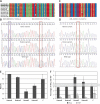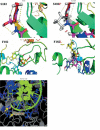KLF1 gene and borderline hemoglobin A2 in Saudi population
- PMID: 29379553
- PMCID: PMC5778434
- DOI: 10.5114/aoms.2018.72245
KLF1 gene and borderline hemoglobin A2 in Saudi population
Abstract
Introduction: Elevated HbA2 (hemoglobin A2) level is considered the most reliable hematological parameter for the detection of β-thalassemia carriers. However, some carriers are difficult to recognize because the level of HbA2 is not in the distinctive carrier range, i.e. 4.0-6.0%; instead, some carriers have HbA2 levels between normal and carrier levels, i.e. borderline HbA2 (HbA2 = 3.1-3.9%). Studies have shown that variations in the erythroid Krüppel-like factor (KLF1) gene lead to borderline HbA2 in β-thalassemia carriers from various populations. The incidence of borderline HbA2 in Saudis is high.
Material and methods: To confirm the influence of variations in KLF1, HBA1, HBA2 and HBB genes for the reduction of the level of HbA2 in Saudi β-thalassemia carriers, we performed a direct sequence analysis of KLF1, HBA1, HBA2 and HBB genes from 212 healthy Saudis (88 subjects: HbA2 < 3; 72 subjects: HbA2 = 3.1 to 3.9; 52 subjects HbA2 > 4.3).
Results: The presence of the borderline HbA2 level is not specific to any type of β-thalassemia variation or β+-thalassemia variations in Saudis. Two exonic (c.304T>C and c.544T>C) and two 3' untranslated region (3'UTR) (c.*296G>A and c.*277C>G) variations have been identified in the KLF1 gene for the first time from an Arab population. None of these four variations in KLF1 genes are significantly associated with the Saudis with borderline HbA2. α Globin genotype, -α23.7/α1α2, is found to be the most frequent (55.55%) among healthy Saudis with borderline HbA2 compared with the other groups (HbA2 < 3 = 20.45%; HbA2 > 4.3 = 13.51%).
Conclusions: Further studies are necessary to determine the influence of other factors on the presence of borderline HbA2 in 41.67% of Saudis.
Keywords: HBA1 gene; HBA2 gene; HBB gene; KLF1 gene; Saudi Arabia; borderline HbA2; variations; β-thalassemia carrier.
Conflict of interest statement
The authors declare no conflict of interest.
Figures


References
-
- Akhtar MS, Qaw F, Borgio JF. Spectrum of alpha-thalassemia mutations in transfusion-dependent beta-thalassemia patients from the Eastern Province of Saudi Arabia. Hemoglobin. 2013;37:65–73. - PubMed
-
- Borgio JF, AbdulAzeez S, Naserullah ZA, et al. Mutations in the beta-globin gene from a Saudi population: an update. Int J Lab Hematol. 2016;38:e38. - PubMed
LinkOut - more resources
Full Text Sources
Other Literature Sources
Miscellaneous
